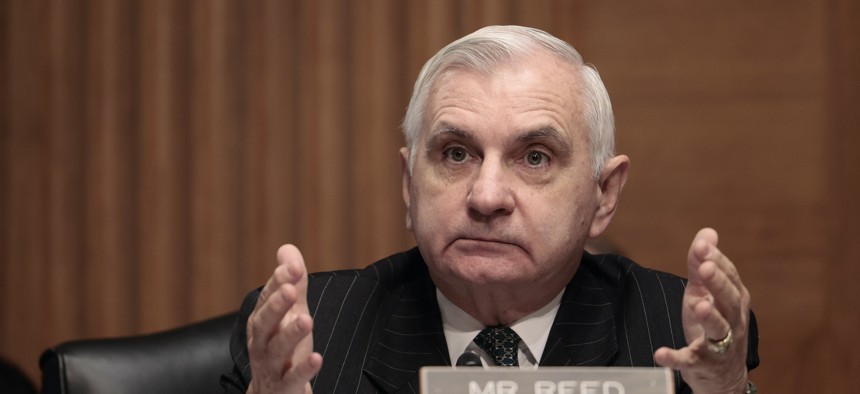Senate panel approves $45B boost to 2023 defense topline

Sen. Jack Reed, chairman of the Senate Armed Services Committee. Getty Images / Anna Moneymaker
The House draft followed Biden’s budget, but lawmakers are expected to debate the funding number next week.
The Senate Armed Services Committee on Thursday approved $817 billion for the Defense Department in fiscal 2023, topping the Biden administration’s request by $45 billion and setting up a discrepancy with counterparts in the House.
Since the administration released its budget request in late March, the White House has sent billions of dollars to Ukraine to help beat back Russia, China has ramped up its provocative actions towards Taiwan, and the United States has seen soaring inflation that drive up the cost of things like fuel. This has prompted lawmakers from both parties to call for defense spending to increase to meet those rising threats.
The Senate’s bill includes $817.33 billion for the Defense Department, according to a summary of the legislation released by the committee. Combined with national-security funding at the Energy Department and other defense programs outside the jurisdiction of the bill, the total national defense topline would be $857.64 billion.
That’s nearly 6 percent more than the $773 billion President Joe Biden requested for the Pentagon, and more than 5 percent up from his total national defense request of $813 billion.
Half of the additional $45 billion in the Senate’s bill will go to offset inflation, a Senate Armed Services Committee staff member told reporters Thursday. The rest of the money will cover some unfunded priority requests from military leaders, replenish munitions drained by the weapons shipments to Ukraine, and fully fund the Ukraine Security Assistance Initiative.
The higher topline is one of the most obvious differences between the Senate legislation and a House version of the bill that will be considered Wednesday by the House Armed Services Committee. The House draft includes $772.5 billion for the Defense Department, about $20 million less than the Pentagon’s request, according to a copy of the bill obtained by Defense One.
It’s not clear what the final funding number will be. Lawmakers are expected to debate and possibly amend the topline of the House bill before approving the legislation on Wednesday. The respective bills will need to pass the full Senate and House, the latter of which has a vocal cadre of progressive lawmakers who historically have sought to cut defense spending. Then staff will reconcile the two bills into a final version that will need to pass both chambers and be signed by Biden.
To become reality, the funding levels set by authorizers will need to be supported by appropriators who are in the midst of their own debate process. The House Appropriations Defense Subcommittee on Wednesday approved a bill in line with Biden’s request that includes a $762 billion topline. The bill’s jurisdiction is different from the NDAA and does not include some national security efforts, including military construction and Energy Department programs.
Members on both sides of the aisle, as well as members of Biden’s own administration, have acknowledged that the funding could increase because of how much America’s national security situation has changed since the budget was released in March.
Rep. Adam Smith, D-Wash., chairman of the House Armed Services Committee told reporters on Wednesday that he expected the increase in the House bill topline is “not going to be an insignificant amount.
"In the short term, we're just going to try to pass the bill and I'm certain that there will be an amendment offered to increase the defense budget," Smith said during a Defense Writers Group event.
Rep. Michael Turner, R-Ohio, a senior member of the House committee, also told Defense One that “up is definitely the direction we need to go,” though he declined to give a dollar figure he would support.
“This administration put together the defense budget pre-Ukraine conflict, and in that, we didn’t have the needs that we’re going to have to backfill the weapons that we have given to Ukraine,” Turner told Defense One. “At the same time, China has become even more emboldened….China and Russia are neither figured into this budget as we see it, and I think that’s going to require an increased topline.”
Both the House and Senate bills include ways to make sure the Pentagon has the money and ability to replenish munitions stockpiles that have been raided to send weapons to Ukraine. The House bill would require the Pentagon to brief congress every quarter on what progress the department is making towards replenishing its munition stores. The bill also orders a federally funded research and development center study on the supply chain for munitions and how quickly production can be ramped up if needed.
The Senate bill includes more than $2.7 billion to produce more munitions and expand the industrial base’s capacity because lawmakers are concerned about fragility in the supply base for critical weapons like Javelins and Stingers, a second Senate committee staffer said.



